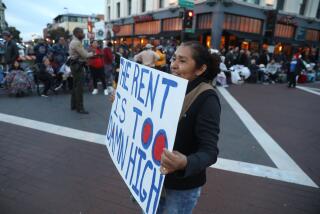U.S. income inequality is bad, but wealth inequality is a bigger problem

Emmanuel Saez, that assiduous tracker of economic inequality in the U.S., has been shifting his attention away from income inequality to a broader, thornier and more intractable issue: wealth inequality. As he observes in a paper published this week at the blog of the Washington Center for Equitable Growth, wealth inequality is “exploding,” constituting “a direct threat to the cherished American ideals of meritocracy and opportunity.”
Saez, an economics professor at UC Berkeley, wrote his paper with Gabriel Zucman of the London School of Economics. A longer, more technical version of their post can be found here. They draw a line from “Capital in the Twenty-First Century,” the magisterial book by Saez’s frequent coauthor, Thomas Piketty, to point out that increasing concentration of wealth feeds on itself, becoming ever more difficult to remedy.
Saez and Zucman find that current sharp uptrend in wealth inequality is a reversal of nearly a half-century of “democratization of wealth,” from the 1930s through the late ‘70’s. At that point, the top 0.1% owned 7% of total U.S. household wealth. By 2012 that figure was 22%. Today their share of wealth is “almost as high as in the late 1920s.” And we know how that turned out.
Among the fascinating findings of Saez and Zucman is how thoroughly the top 0.1% have shouldered their way past all other households. While their wealth share was soaring, that of the next 0.9% was barely growing, while that of the “merely rich” -- those ranking in the top 10% but below the top 1% -- actually shrank.
But the real victims of the trend are in the middle class. Saez and Zucman show that the wealth share of the bottom 90% grew from the 1920s through the mid-1980s, from 15% to 36%. Mostly the gain was due to the growth of pensions and of homeownership. Since the mid-1980s, however, middle-class wealth has evaporated, falling to 23% in 2012, about the same level as 1940.
The authors blame sharply rising indebtedness; of course, the collapse of stock values and home prices in recent years has destroyed a huge volume of middle-class wealth. The top 1% have been able to recover much of that wealth, but the bottom 90% have continued to fall. They’ve continued to be dependent on housing and pensions, both of which have continued to be very shaky legs of a tottering stool.
Wealth inequality is also an artifact of income inequality; the two trends work together to magnify the former. As the bottom 90% struggle to make ends meet on stagnant incomes, they’re unable to accumulate savings. “Today, the top 1% save about 35% of their income,” the authors write, “while bottom 90% families save about zero.”
Strong measures will be needed to reverse this otherwise inexorable trend, they write. “Ten or twenty years from now, all the gains in wealth democratization achieved during the New Deal and the post-war decades could be lost. While the rich would be extremely rich, ordinary families would own next to nothing, with debts almost as high as their assets.”
Among their prescriptions for the rebuilding of middle-class wealth are higher taxes on capital income -- “current preferential rates on capital income compared to wage income are hard to defend in light of the rise of wealth inequality” -- and on inheritances. “Estate taxation is the most direct tool to prevent self-made fortunes from becoming inherited wealth -- the least justifiable form of inequality in the American meritocratic ideal.” Progressive estate and income taxation were the key tools that reduced the concentration of wealth after the Great Depression,” they write. “The same proven tools are needed today.” (N.B.: See Ed Kleinbard of USC for a related take.)
Modern-day conservatives will shudder at the Saez-Zucman program, but it would fit well within the world view of the Founding Fathers. Thomas Jefferson and his fellows were deeply hostile to the accumulation of great wealth, especially by inheritance. In a famous 1812 letter to the printer Joseph Milligan, Jefferson acknowledges that “the overgrown wealth of an individual [may] be deemed dangerous to the State.”
In economic terms, he wrote to James Madison, “whenever there is in any country, uncultivated lands and unemployed poor, it is clear that the laws of property have been so far extended as to violate natural right.”
And in his autobiography Jefferson wrote of the bills he had advocated or passed to form “a system by which every fibre would be eradicated of antient [sic] or future aristocracy; and a foundation laid for a government truly republican.” His goal was to “prevent the accumulation and perpetuation of wealth in select families, and preserve the soil of the country from being daily more & more absorbed in Mortmain” (that is, the perpetual ownership of real estate by a church, corporation, or other legal entity).
Jefferson was in many ways a modern man, but his goals have come to naught, in part because the very legal measures he advocated have been dismantled by conservatives acting, supposedly, in his name. The aristocracy is again on the rise, and the republic and its economy are very sick.
Keep up to date with the Economy Hub. Follow @hiltzikm on Twitter, see our Facebook page, or email mhiltzik@latimes.com.







